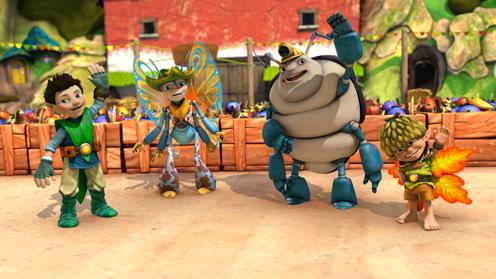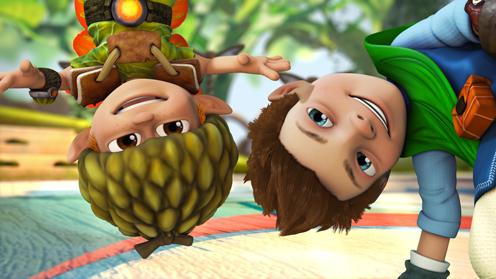Tree Fu Tom is about the amazing adventures of a young boy called Tom who, with the power of ‘movement magic’ called ‘Tree Fu’, can transform into a tiny but mighty magical super hero and travel to a wondrous enchanted kingdom called Treetopolis that exists in a tree in his back garden. It is only with help from the audience performing Tree Fu moves and passing their magic through the screen that Tom can create spectacular Big World Magic and save the day! As the audience joins in with Tom, they too become superheros! The Tree Fu moves have a “cool” martial-arts type feel (which is particularly engaging for boys). However, the programme is equally appealing to girls with its beautiful animation, captivating any girl who is interested in fairies and elves.
 Tree Fu Tom’s movement-based spells are fun and engaging for all children, and were developed from the movements used to help children with Dyspraxia and other developmental co-ordination disorders. Spells include movements typically used by physiotherapists and occupational therapists to develop areas such as balance, strength in the shoulders and around the hips, use of both sides of the body together and separately, spatial awareness, hand co-ordination, and body awareness. The spell sequences have been designed to assist and enhance the development of important foundation motor skills in all children – regardless of whether they have any movement challenges – at a crucial time in their growth.
Tree Fu Tom’s movement-based spells are fun and engaging for all children, and were developed from the movements used to help children with Dyspraxia and other developmental co-ordination disorders. Spells include movements typically used by physiotherapists and occupational therapists to develop areas such as balance, strength in the shoulders and around the hips, use of both sides of the body together and separately, spatial awareness, hand co-ordination, and body awareness. The spell sequences have been designed to assist and enhance the development of important foundation motor skills in all children – regardless of whether they have any movement challenges – at a crucial time in their growth.
Dyspraxia is surprisingly common, affecting approximately 10% of children to some degree (i.e. 1-3 children in every classroom in the UK) and 2% severely. It is an impairment of the organisation of movement and is the result of an immaturity in the development of the nervous system. This means that nerve signals are not transmitted effectively from the brain to the muscles, affecting a person’s ability to perform movements in a smooth, co-ordinated way.
Children with Dyspraxia have difficulty developing the movement skills that seem to come naturally to their peers. Their movements appear awkward and take a lot of effort. They often have poor balance and postural stability and find it difficult to move their arms and legs in a co-ordinated manner. Using both sides of the body together, for example when riding a bike and using cutlery, can be especially challenging. Without these foundation movement skills it is hard for them to carry out everyday activities such as walking up stairs without tripping, bending down to pull on socks and using a pencil to write and draw.
Their difficulties with movement skills can often lead to children with Dyspraxia falling behind at school (despite, often, having above average IQs) and having additional social challenges at school. This is especially apparent for boys whose early social interactions tend to involve physical skill-based activities such as sports.
Understanding of the underlying causes of Dyspraxia is limited but we do know that, given the right opportunities and enough practice, children are able to develop the movement skills they need in their everyday life.
Since children with Dyspraxia and other co-ordination disorders need more opportunities to practise movement skills than their friends, a huge benefit of Tree Fu Tom is that children are eager to join in with the spells and therefore practise their movement skills without even realising. Of course, all children will benefit from more active ‘screen time’ too, and by having a go at Tree Fu magic they will have a lot of fun at the same time, never knowing that the movements they are doing are helping them learn and hone important skills that can help and hopefully improve their development!
Foundation movements are the building blocks that, when added together, create complex movements. If a child has not developed foundation movement skills by the age of six it is likely that they will experience significant difficulties with everyday tasks both at home and in school. The spells in Tree Fu Tom have all been designed to help with the development of foundation movement skills.
 The Tree Fu Tom spells are designed to assist in the development of 12 key physical and neurological skills:
The Tree Fu Tom spells are designed to assist in the development of 12 key physical and neurological skills:
Balance – This is the ability to hold a position without falling over. The two types of balance are static balance and dynamic balance. Static balance refers to our ability to hold a position when we are still, for example when sitting on a chair or when standing in a line. Dynamic balance refers to our ability to hold a position when we are moving around, for example when climbing stairs or running.
Trunk rotation – This is the ability to hold the lower body still whilst turning the upper body to the side. It allows children to twist their body to reach to the side and is important for activities such as throwing a ball and crawling.
Shoulder stability – This is the ability of the muscles to hold the shoulder joint steady. It allows the arms to be held in different positions so that the hands can be used for activities such as writing and using cutlery.
Pelvic stability – This is the ability of the muscles to hold the pelvis steady. It is important for sitting, standing and moving around and also affects control of the hands for activities such as reaching.
Trunk/arm separation – This is the ability to move the arms in a controlled and accurate manner away from the body. It is affected by shoulder and trunk stability and is important for activities such as pouring a drink and throwing a ball.
Trunk/leg separation – This is the ability to move the legs in a controlled and accurate manner away from the body. It is affected by pelvic and trunk stability and is important for activities such as kicking a ball and pedalling a bike.
Fluency of movements – This is the ability to move the body in a smooth and controlled manner. It is important for activities such as drawing, running and spreading butter onto toast.
Proprioception – This is the ability to sense where the body is in space and how it is moving without looking. It is needed for activities such as brushing hair, tucking in shirts at the back, and playing sports like football. It is generated by feedback from the muscles and joints and helps us to sit squarely on a chair and to move around our environment without bumping into people and objects. It also helps us to know how much force we are using so that we can carefully pick up objects and pour a drink.
ATNR – The asymmetrical tonic neck reflex (ATNR) is sometimes known as the “fencing response” and describes the movements of a baby’s arms and legs when their face turns to one side. It is useful in babies as it helps with the development of hand-to-eye coordination, but if it remains in older children it can affect their ability to bring their two hands together, to keep hold of an object whilst looking around a room, and postural stability, for example when children are seated at a school desk.
Spatial Concepts – This refers to the child’s awareness of how their body moves in relation to their position in space, and where objects are in relation to their body. It is important for understanding diagrams and directions (for example up, down, into and away from the body), and for activities such as pulling a jumper over the head and scooping food onto a spoon.
Midline crossing – This is the ability to move one hand or foot across the middle of the body to carry out an activity. It is important for developing hand/foot dominance and for activities such as pulling on a coat and writing across a page.
Fine motor skills – This is the ability to use the hands, fingers and thumbs in a precise and controlled manner. This is important for holding and manipulating objects such as pencils and cutlery.
One of the biggest factors in acquiring and developing new skills is practice. Children learn through a process of trial, error, repetition and copying others. The sequences of spell movements in Tree Fu Tom are repeated, providing an opportunity for children to practise the movements. It is hoped that children will really engage with the spells and incorporate them into their everyday play, repeating them after the show has ended and gaining even more practice!
Succeeding at performing the spells and helping Tom to save the day can have a dramatic positive impact on self-esteem. As children are encouraged to join in with the spells at home, in order to make the magic work on screen, they get the sense that they have made a positive contribution, which may also raise their self-esteem.
All children have the capacity to improve their current movement skills and to gain new skills through practice. The spells in Tree Fu Tom allow children to experience unfamiliar, positive and challenging movement opportunities that, with practice, will really help them to improve their co-ordination and self confidence at a crucial time in their development. Tree Fu Tom is not just entertaining; it is a powerful tool in helping children to experience beneficial movement in a fun and positive way.
